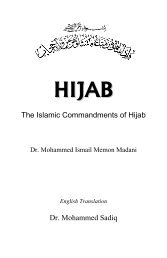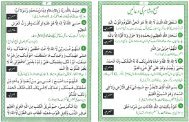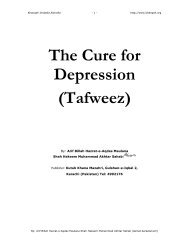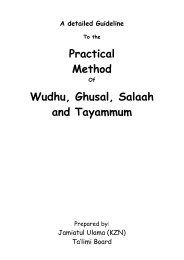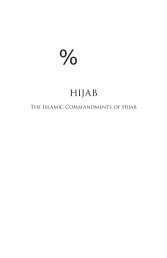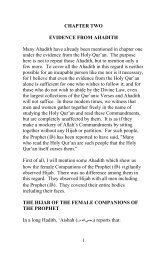This book is a revised edition by Khanqah Imdadia Ashrafia of the ...
This book is a revised edition by Khanqah Imdadia Ashrafia of the ...
This book is a revised edition by Khanqah Imdadia Ashrafia of the ...
You also want an ePaper? Increase the reach of your titles
YUMPU automatically turns print PDFs into web optimized ePapers that Google loves.
<strong>Khanqah</strong> <strong>Imdadia</strong> <strong>Ashrafia</strong><br />
Wudhu, pour water over <strong>the</strong> head thrice (sufficient water should be poured so that <strong>the</strong> entire<br />
body <strong>is</strong> completely drenched). Rub <strong>the</strong> body with <strong>the</strong> hands so that no part remains dry. If even<br />
a hair span <strong>is</strong> left dry, <strong>the</strong> ghusl will be incomplete. In short, ensure that water passes over <strong>the</strong><br />
entire body. Thereafter, move away from th<strong>is</strong> place to a pure spot to wash one’s feet. If,<br />
however, <strong>the</strong> feet had been washed at <strong>the</strong> time <strong>of</strong> Wudhu, <strong>the</strong>n <strong>the</strong>re <strong>is</strong> no need to repeat.<br />
(Beh<strong>is</strong>hti Zewar, Shami‐ Vol. 1, pg. 157– 159)<br />
Note: The act <strong>of</strong> wiping oneself with a towel after ghusl <strong>is</strong> also recorded in <strong>the</strong> Hadith. Likew<strong>is</strong>e<br />
not to wipe oneself but to allow <strong>the</strong> water to dry up on its own <strong>is</strong> also recorded in <strong>the</strong> Hadith.<br />
Hence, whichever <strong>of</strong> <strong>the</strong> two methods are adopted, make <strong>the</strong> intention <strong>of</strong> fulfilling <strong>the</strong> Sunnat.<br />
(Nasai‐Vol.1, pg. 31, Tirmidhi‐Vol.1, pg.18, Shami‐ Vol.1, pg. 99)<br />
FARAAIDH OF GHUSL<br />
The above mentioned method <strong>is</strong> <strong>the</strong> sunnat procedure for ghusl. In ghusl, some acts are<br />
compulsory without which one’s ghusl will not be correct and one will remain impure. Thus it <strong>is</strong><br />
necessary to have <strong>the</strong> knowledge <strong>of</strong> what <strong>is</strong> compulsory in ghusl. Only three acts are compulsory<br />
in ghusl.<br />
1. To gargle one’s mouth (in such a method that water reaches <strong>the</strong> entire mouth.)<br />
2. To place water in <strong>the</strong> nose ( upto <strong>the</strong> s<strong>of</strong>t portion)<br />
3. To make water reach <strong>the</strong> entire body.<br />
SUNNATS OF AZAAN AND IQAAMAH<br />
1. It <strong>is</strong> Sunnat to face <strong>the</strong> Qibla while saying <strong>the</strong> Azaan and Iqaamah. ( Maraaqiul Falaah‐ pg. 106,<br />
I’laaus‐sunan‐Vol.2, pg.126)<br />
2. It <strong>is</strong> Sunnat to say <strong>the</strong> Azaan with pauses after each phrase while <strong>the</strong> Sunnat method <strong>of</strong> Iqaamah<br />
<strong>is</strong> to say it quickly. (Tirmidhi‐ Vol.1, pg.285)<br />
3. During <strong>the</strong> Azaan it <strong>is</strong> Sunnat to turn <strong>the</strong> face to <strong>the</strong> right when saying:<br />
and towards <strong>the</strong> left when saying<br />
However, <strong>the</strong> chest and <strong>the</strong><br />
feet should remain towards <strong>the</strong> direction <strong>of</strong> <strong>the</strong> Qibla. (Maraaqi‐pg.106, Shami‐Vol.1, pg. 285)<br />
4. It <strong>is</strong> Sunnat to repeat <strong>the</strong> words <strong>of</strong> <strong>the</strong> Azaan after <strong>the</strong> Muazzin (in reply to <strong>the</strong> Azaan). When <strong>the</strong><br />
Muazzin call out<br />
reply with:<br />
and<br />
http://www.khanqah.org



